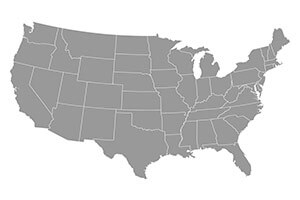
UNITED STATES
Colonies had been placed in holding yards in California and were scheduled to be moved into the almond groves later in February. Prices for almond pollination have increased by $10 to $15 per hive, bringing the average price to between $180 and $190. Premiums are being paid for strong colonies with more frames of brood. The big weather news in California has been the major turn-around in moisture levels over much of the state. Not only have drenching rains been received, but the mountain ranges have received huge amounts of snow cover, which will be of great help for later honey flows and crop irrigation needs.
As of this writing, winter weather conditions had been on the mild side over much of the southern United States. Of course, late winter or early spring hard frosts are always a danger, but beekeepers had their fingers crossed. Unfortunately, several southern states, especially in the Southeast, are still fighting drought conditions which could hurt spring colony buildup and later honey flows. The northern half of the country has had rather mixed winter weather conditions. At times, mild weather and cleansing flights have been available to colonies. On the other hand, in some parts of the country extended cold had been hard on overwintering beeyards. Especially hard hit has been those areas of the country that had poor late summer or fall flows, causing bees to face winter with a shortage of stores. Extensive feeding has helped in some cases, but other reports indicate large winter losses to starvation have already occurred.
Wholesale honey trading has been rather slow due a shortage of unsold honey, but in some cases beekeepers have noted price increases for varietal or white honey. On the other hand, quotes on bakery-grade honey have at times been lower.
NORTHEAST
Beekeepers were starting to assess their winter losses, but cold weather often prevented beeyard inspections. Early snowfall was sparse and this has caused concern regarding needed ground moisture for spring flowers. However, later good snows and rains have helped alleviate drought conditions in several Northeastern states. Some beekeepers reported adding sugar patties or candy boards to colonies low on stores. Beekeepers have been worried about winter losses since colonies entered winter with lower than normal stores in some states. Judging by early sign-ups for packaged bees and nucs, as well as early registrations for bee classes, reporters believe interest in hobby beekeeping will continue to be strong this year. Most of last year’s locally produced honey has been sold and demand remains strong at the retail level and for small wholesale lots sold to local packers and bakers.
MIDEAST
Beekeepers were trying to avert more colony losses due to starvation by intervening with candy boards, winter patties or syrup. Unfortunately, a number of colonies went into winter with below normal stores due to poor late honey flows. Another major concern in several area states is the continuing drought which could hurt important spring honey flows. In some states winter rains and snow have helped the dry conditions, but more moisture is needed. Many beekeepers had already ordered replacement packages or nucs after discovering large colony losses due to starvation in their apiaries earlier this winter. Some beekeeping groups are experimenting with using more locally raised queens in an effort to improve overwintering and mite resistance. This area has seen more than its share of natural disasters over the last year with flooding, tornadoes and wildfires. Most beekeepers sold the remainder of their crop during the holiday season, so they will are anxious for new crop honey to start coming into their hives.
SOUTHEAST
Beekeepers are feeding colonies in preparation for spring flows and spring divides. Early build-up sources like maple, willow, elm and wildflowers were helping when foraging weather was available. Drought continues to be a major concern in several Southeastern states, although some states were starting to receive more moisture. Earlier in the winter drought was blamed for starvation bee losses in several Southeastern states because it caused a nectar dearth. Package bee and queen companies were busy taking orders and building up their colonies in preparation for another very busy season. The first half of the winter was generally described as normal to mild. Beekeepers were hoping that no major late freezes would put a damper on colony buildup. Florida beekeepers were not expecting major flows from the orange groves which continue to be an unreliable and shrinking source for honey crops in the state.
With so many beekeepers moving their bees into Florida for overwintering, colony crowding is an increasing problem. Elsewhere in this area, beekeepers and bees are getting busy after a few months of inactivity. Less than 10% of last year’s honey crop remains in the hands of beekeepers. The weak wholesale honey market remains a major concern due to the continued influx of cheap foreign honey. Prices have increased for superior grades of honey, even though bakery-grade prices have declined. Retail sales have not been affected, however. Many colonies were moved to the almond groves in California, but will be returning to their respective states in late March or early April. Prices for almond pollination have increased by $10 to $15 per colony over last year.
SOUTHWEST
With milder weather conditions, colonies have started to build up on maple, elm, willow and assorted wildflowers. Beekeepers are also augmenting colony stores with sugar syrup and pollen sub where needed. As in the Southeast, many northern colonies are moved to these southwestern states for the winter months and will be fed and split before being transported back to their northern home yards. In Arizona and New Mexico, the big wildflower bloom has started and should provide nice surpluses for beekeepers, along with limited …


